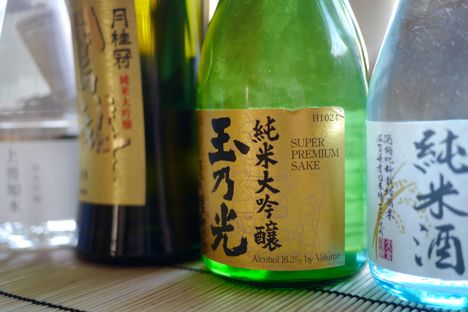
Flavours of Japan: sake
Victoria delves into the world of sake, the rice wine (that's actually brewed like beer) drunk throughout Japan. As with wine, there are lots of varieties and uses, both for drinking and cooking, as well as a rich history within Japanese culture.
Flavours of Japan: sake
Victoria delves into the world of sake, the rice wine (that's actually brewed like beer) drunk throughout Japan. As with wine, there are lots of varieties and uses, both for drinking and cooking, as well as a rich history within Japanese culture.
View more from this series:
Flavours of JapanSake is the national drink of Japan. There’s some dispute about its origins, but Kojiki, Japan's first written history, compiled in circa 712 AD, makes several references to an alcoholic drink made from rice. Traditionally, sake has been used ceremoniously and is often consumed as part of Shinto purification rituals. In Shinto wedding ceremonies, the bride and groom take turns drinking sake from three different bowls, each one bigger than the one before. Sharing from the bowls represents the couple sharing the joys and sorrows of life together.
What is sake?
Fermented from rice (koji), you’d be forgiven for assuming that sake is a distilled beverage, given its pure crystal clear colour. In fact, sake is brewed in a similar way to beer. Rice is milled, meaning it has no husk and therefore no enzymes. Because of this, sake does not undergo a malting process like beer does. Instead, koji-kin (rice mould) is cultivated and used to break down the rice starch into sugar, which in turn feeds the yeast. Unlike beer, the process of fermentation occurs simultaneously to saccharification (when starch converts to sugar). This multiple parallel fermentation technique is unique to sake and explains the old adage that sake is brewed like a beer, but drunk like a wine.
Different types of sake
The flavour profile of sake varies from dry to slightly sweet, but the goal is always balance. The rice in premium sakes (tokutei meishoushu) is highly polished, giving a more refined, delicate and fruitier palate.
There are approximately sixty-five varieties of rice designated as sake rice. Like wine grapes, different types of rice grow best in particular regions and some are more prized than others. Yamada Nishiki, Gohyaku Mangoku and Omachi are all highly renowned varieties.
The starch in sake rice is concentrated in the centre of the grain. The polishing process removes lipids and minerals on the outside resulting in a cleaner, more fragrant brew. Premium sakes are divided into junmai sake and non-junmai sake. Junmai is made purely from rice, whereas non-junmai typically has added brewer’s alcohol.
Non-premium sake, futsushu, accounts for seventy-five percent of all the sake produced in Japan. It is the equivalent of table wine and is reasonably priced and versatile. Futsushu is often overlooked in the West in favour of premium sakes, but good futsushu can be wonderful. Other types of sake include nigori, a cloudy sake which is more rustic and less smooth on the palate, as well as sparkling, aged and flavoured varieties.
Most sake is clear, but some may have a pale golden or amber hue. If sake has been left in direct sunlight or allowed to age, it will degrade and turn a darker, flat brown colour. Sake that has degraded to this level is best avoided.
Premium sake classifications
The top classification of premium sake is junmai daiginjo, which is exceptionally smooth and clean and deliciously light and fruity. I used Tama no Hikari Sake, a junmai daiginjo sake, in my recipe for Sake Fizz. The cocktail showcases its light, dry profile and complex fragrance. I also used a junmai daijingo sake in my Mandarin and sake trifle. Gekkeikan Horin Junmai Daiginjo adds a layer of luxury to the dessert, with notes of cantaloupe, pear and honeysuckle.
The second classification of sake is junmai ginjo, which, although not quite as refined as junmai daiginjo, is still wonderfully balanced and refreshing and is best served chilled. I used Shirataki Shuzo Jozen Mizuno Gotoshi Junmai Ginjo Sake in my recipe for Sake-steamed mussels, due to its crisp, dry and light character. It is a perfect pairing with seafood, both in the dish and served chilled to drink alongside it.
The third classification of premium sake is junmai and honjozo. The focus in these sakes is the flavour of the rice. These sakes are wonderful paired with food and can be drunk at a variety of temperatures. I used Gekkeikan Gensen Sozai Junmai Sake in my Sake-marinated lamb rump served with aubergine and miso purée and crispy sesame soba noodles, due to its dry and full-bodied profile; a refined sake for a sophisticated dish.
What temperature should sake be drunk at?
Despite James Bond’s insistence in You Only Live Twice that sake should be 'served at the correct temperature: 98.4°F', the complex character of most premium sakes benefit from being chilled, but over-chilling may mute its fragrance. Heating sake changes the perception of alcohol on both the nose and the palate.
The temperature the sake is served at will affect the balance of flavours. Chilled sake tastes lighter, drier and fruitier, but on warming, the same sake will taste sweeter, with more umami.
The temperature for drinking sake is largely a matter of personal preference. Many good sakes are delicious warmed in a tokkuri, but it’s best to avoid over-heating. In Japan, cheap, low-grade sakes are often served piping hot to disguise their harshness.
To find your preferred style and temperature of sake, the best and most fun way is through extensive tasting. Sakes don’t generally keep that well, so are best kept refrigerated after opening and finished quickly. No great hardship, I’m sure you’ll agree.

